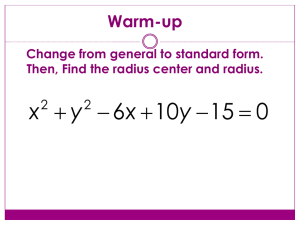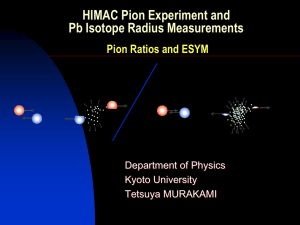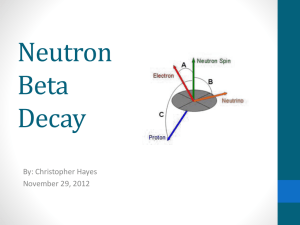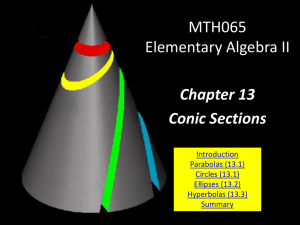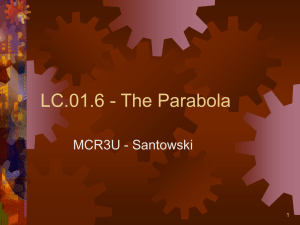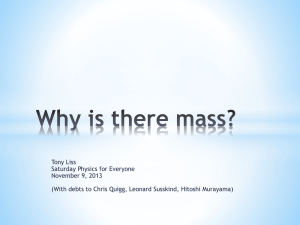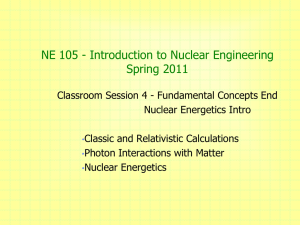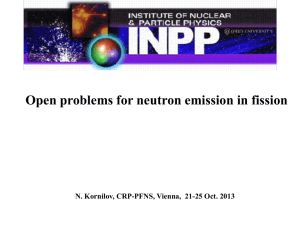SEMF application I - Department of Physics, HKU
advertisement
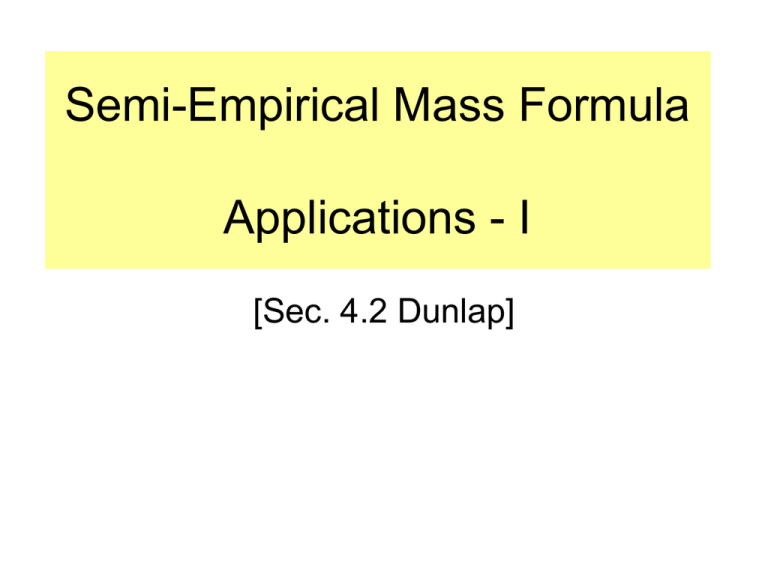
Semi-Empirical Mass Formula Applications - I [Sec. 4.2 Dunlap] Pairing Energy Deuteron Triton - particle The saturated sub-unit in the nucleus consists of 2 protons and 2 neutrons. This suggests, in conjunction with the Pauli Exclusion Principle (PEP) and in analogy with electronic shells in an atom, that the basic quantum state – an S-(J=0) state – consists of 2 protons and 2 neutrons with antiparallel spins as shown. 5He does not exist as a bound state (this state breaks up ~10-21s. The PEP allows us to put at most 2p and 2n in a relative S-state. Any additional nucleon must go into a higher spatial quantum state. Because the -particle and not the deuteron (2H) is the saturated sub-unit, this shows that the force between nucleons is attractive in both the singlet () and triplet () states. Pairing Energy B/A (MeV) FUSION FISSION Note that extra strong binding occurs for: 4 2 He, 8 4 Be, 12 6 C, 14 7 N, 16 8 O, 20 10 Ne , (Scale not linear) 24 12 Mg Pairing Energy Why does the pairing energy “drop off” as A-3/4. This is something to do with the fact that nucleons do move on trajectories around the nuclear volume and do interact with other nucleons. The larger the nucleus the less the effect of the nucleon-nucleon interaction within the alpha sub ( r , , ) unit. A deeper understanding of the pairing energy will come when we study the SHELL MODEL. Mass Parabolas Let’s remind ourselves on the full form of the SEMF. The mass M(A,Z) of the nucleus ZA X is given by: 1 A M Z X M ( A, Z ) ( A Z )m n Z (m p m e ) 2 B A, Z c B ( A , Z ) aV A a S A 2/3 aC Z A 2 aA 1/ 3 ( A 2Z ) A 2 aP 1 A 3/4 or as one equation: M ( A, Z ) ( A Z )m n Z (m p m e ) aA ( A 2Z ) Ac 2 2 aP A 3/4 c 2 aV A c 2 aS A c 2 2/3 aC Z A 1/ 3 2 c 2 Cf. Eq. 4.12 Collecting together powers of Z, it is seen that this expression is quadratic in Z Mass Parabolas Consider the case of odd A when aP=0 aV A M ( A , Z ) ( A Z ) m n Zm H 2 c collecting terms a a a M ( A , Z ) m n V2 2A 1 / 3S 2 . A c c A c aS A c 2 2/3 aC Z A 1/ 3 2 c 2 aA ( A 2Z ) Ac 2 4a 2 A m n m H Z c aC 2 4a A 1/ 3 2 Z 2 A c Ac 2 M ( A, Z ) M A ( Z ) . A Z Z we have a mass parabola ! with mn aV c 2 aA c 2 4a aS A 1/ 3 c 2 M(A,Z) - 2 A m n m H c 4a A Ac 2 aC A 1/ 3 c 2 Z 2 Mass Parabolas Proton number Z=N Z increasing ISOBARS A=Z+N=const. Neutron number Mass Parabolas – Odd A Neutron rich Proton rich Fig 4.3 Mass parabola for A=135 showing One Stable Nuclide with Z=56 +, EC We can find from the SEMF mass parabola an equation for the minimum of the MA(Z) curve Physically one is always having tight binding on either the neutron side or the proton side of the nucleus. Mass Parabolas - Odd A To minimize M ( A , Z ) M A ( Z ) . A .Z .Z MA(Z) 2 Set the derivative wrt. Z = 0 M A Z 2Z 0 Z0 Z Z Z0 2 Remembering that: mn aV c 2 aA c 2 4a aS A 1/ 3 - 2 A m n m H c 4a A Ac 2 aC A 1/ 3 c 2 c 2 Z0 4 a A (m n m H )c 2 aC 4a A 2 1/ 3 A A Note that Dunlap 4.13 has a mistake: Mass Parabolas - Odd A Z0 4 a A (m n m H )c 2 aC 4a A 2 1/ 3 A A Lets calculate for A=135: ( m n m H ) c 0 . 78 MeV 2 a C 0 . 72 MeV a A 23 . 2 MeV Z0 4 x 23 . 2 0 . 78 MeV 4 x 23 . 2 0 . 72 2 MeV 1/ 3 135 ( 135 ) 93 . 2 0 . 78 2[ 0 . 687 0 . 14 ] 56 . 5 We may have hoped for slightly better agreement – experimentally the value of Z0 =55.7. But this shows that the global parameters for the SEMF have only limited accuracy. However remember that we are some way from Z=A/2=67.5 Mass Parabolas - Odd A Z0 4 a A (m n m H )c 2 aC 4a A 2 1/ 3 A A Note that to a good approximation we can neglect ( m n m H ) c compared to 4aA 2 So that to a good approximation we get: Z0 where: A 1 2 1 A aC 4a A 2/3 0 . 72 MeV 7 . 76 x 10 3 4 x 23 . 2 MeV Applying this to the case of A=135 we get: Z 0 67 . 5 1 1 7 . 76 x 10 3 x (135 ) 0 . 66666 56 . 05 which is quite good because using the full expression gave Z0=56.5 Mass Parabola – Odd A (looking down the valley of stability, i.e. decreasing A) Note that the energy released in either (neutron rich) or EC decay (proton rich) can be expressed in terms of the parabolicity and Z0 You can work these expressions out yourself – it is easy. Mass Parabolas - even A (looking down the valley of stability – A decreasing) Note that for even A there exist two mass parabolas – the top one for low pairing energy A=140 binding (ODD-ODD) and the bottom one for high binding energy (EVEN-EVEN) odd-odd even-even Note that some decay such as 140Nd140Pr have quite low Q energy, while other such as 140Pr140Ce have large Q energy Mass Parabolas - even A (looking down the valley of stability – A decreasing) A=128 Sometimes the positioning of the isobars is such that one can get TWO STABLE ISOBARS Eg. 128Te and 128Xe and the strange phenomenon that a nuclide such as 128 I can both + and - decay! The displacement of the parabolas is of course 2 2aP A 3/4 Mass Parabolas – Even A The decay energies are given by the same expressions as for Odd A – except now one either subtracts or adds a 2 Beta minus decay – Q value Ze- Ze- Q- β+ Decay A A A Z X N Ze Z 1Y N 1 Ze e A Z X N Ze Z 1Y N 1 ( Z 1) e e e ELECTRON CAPTURE DECAY A beta emitter– and beta + emitter 1 0 Half - life 12.7h 64 29 Cu 0 Spin and parity of nucleus 64 30 EC 2 m e c 1 . 022 MeV Zn 2 64 28 Q 0 . 5782 Ni Q EC 1 . 6749 Q 1 . 6749 1 . 022 0 . 653 These are what will be quoted Beta plus and Beta minus spectra The momentum spectra for beta plus (right) and beta minus (left) are shown for 64 Cu. The end-point energies for these decays are approximately the same (0.654 MeV) – Beta Plus and (0.578 MeV) –Beta minus. Note though (i) the spectrum are continuous because of the sharing of energy between three particles, and (ii) that the Beta plus spectrum is skewed to higher momentum (the beta minus to lower momenta). Neutron separation energy Energy + Sn A Z X Z Y N 1 n A N S n M ( Y N 1 ) m n M ( X A Z A Z N )c 2


